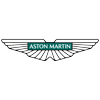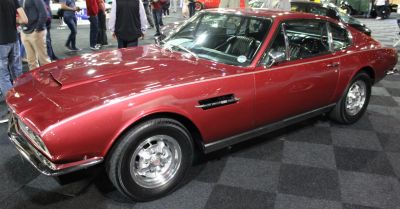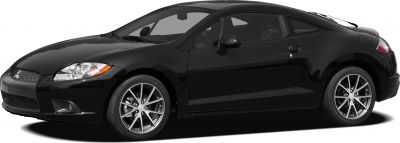 1967 Aston Martin DBS Dimensions, Size & Specs
1967 Aston Martin DBS Dimensions, Size & SpecsMeasurements of the 1967 Aston Martin DBS, engineered for optimal performance and comfort
| Dimensions | |
|---|---|
| Length: | 4580 mm180.3 in15.0 ft |
| Width: | 1830 mm72.0 in6.0 ft |
| Height: | 1330 mm52.4 in4.4 ft |
| Ground Clearance: | 140 mm5.5 in0.5 ft |
| Weight Specifications | |
| Curb Weight: | 1588 kg3501 lbs |
The Aston Martin DBS, produced between 1967 and 1972, represents an iconic British grand tourer that seamlessly blends sporty performance with elegant design. This two-door coupe features a length of 4580 mm (180.3 inches), a width of 1830 mm (72.0 inches), and a height of 1330 mm (52.4 inches), offering a sleek and low-slung silhouette typical of luxury sports cars of its era. With a curb weight of 1588 kg (3504 lbs), the DBS balanced solid road presence and agility, ensuring a dynamic driving experience while maintaining comfort for its occupants. The ride height or ground clearance measures 140 mm (5.5 inches), suitable for confident handling on both highways and winding country roads. Renowned for its classic styling and powerful V8 engine options, the 1967-1972 Aston Martin DBS was a luxurious yet performance-focused vehicle that competed with contemporaries like the Jaguar E-Type and Ferrari 365 GT 2+2. Its combination of refined dimensions, a relatively wide stance at 1830 mm, and a moderate length of just over 4.5 meters created a grand tourer that excelled in both stability and elegance. Today, the DBS from this period remains a sought-after classic, known not only for its performance and style but also for the balanced proportions that contributed to its timeless appeal. Whether you’re comparing classic car sizes or exploring vintage British sports car dimensions, the Aston Martin DBS stands out as a prime example of 1960s grand tourer excellence.
Discover the standout features that make the 1967 Aston Martin DBS a leader in its class
Have a question? Please check our knowledgebase first.
The 1967 Aston Martin DBS has a length of 4580 mm (180.3 inches), a width of 1830 mm (72.0 inches), and a height of 1330 mm (52.4 inches). These dimensions give it a sleek and low-slung profile typical of grand tourer coupes of its era, making it compact enough for sporty handling yet spacious for a luxury coupe.
The 1967 Aston Martin DBS has a curb weight of 1588 kg (3503 lbs). This relatively moderate weight for a grand tourer of its time allows the car to balance performance and comfort effectively. Keeping the weight under 1600 kg helped optimize the car's power-to-weight ratio, contributing to agile handling characteristics and strong acceleration from its powerful inline-6 engine.
The 1967 Aston Martin DBS has a ride height or ground clearance of 140 mm (5.5 inches). This relatively low clearance enhances the vehicle's stability and cornering ability by lowering the center of gravity. However, it also means the car is less suited to rough or uneven surfaces, making it ideal for paved roads and high-speed touring rather than off-road driving.
Yes, the 1967 Aston Martin DBS can fit into a standard garage. Its length of 4580 mm (180.3 inches) and width of 1830 mm (72.0 inches) make it relatively compact compared to modern luxury cars. Typical single-car garages offer dimensions of at least 2400 mm (94.5 inches) width and 4800 mm (189 inches) depth, allowing the DBS to fit comfortably with some space for additional maneuvering or storage.
Compared to its predecessor models, such as the Aston Martin DB6 (1965–1970), the DBS is slightly more modern and performance-oriented in both design and dimensions. The DBS body was more angular and featured a wider stance at 1830 mm (72.0 inches) compared to the DB6's 1781 mm (70.1 inches) width, making the DBS feel more spacious in the cabin. However, length and height values were generally similar, maintaining a low and elegant grand touring silhouette.
Dimensionally, the 1967 Aston Martin DBS compares favorably with contemporary grand tourers such as the Jaguar E-Type Series 2 and the Ferrari 365 GT 2+2. The DBS's length of 4580 mm (180.3 inches) is close to the Jaguar E-Type Series 2's 4480 mm (176.4 inches) and slightly shorter than the Ferrari 365 GT's 4700 mm (185.0 inches). Width-wise, its 1830 mm (72.0 inches) is slightly wider than the E-Type, allowing for a more spacious cabin. These comparisons highlight the DBS as a well-sized and competitive grand tourer of its era.
Given its exterior dimensions of 4580 mm length and 1830 mm width, the 1967 Aston Martin DBS offers a comfortable cockpit for four occupants arranged in 2+2 seating configuration. The cabin prioritizes luxury and driving experience, with ample headroom due to the 1330 mm (52.4 inches) height and a well-designed interior layout optimizing space. While rear seats are more suitable for occasional passengers or children, the overall interior feel is spacious for a grand tourer coupe, combining comfort with sportiness.
By modern standards, the 1967 Aston Martin DBS is considered relatively compact, especially compared to contemporary luxury grand tourers and SUVs. Its length of 4580 mm (180.3 inches) and width of 1830 mm (72.0 inches) make it maneuverable in urban environments and parking easier than many larger modern cars. Its relatively low height of 1330 mm (52.4 inches) also aids visibility and center of gravity but means it might require cautious attention in tight parking spaces or garages with height restrictions.
The 1967 Aston Martin DBS’s dimensions and design significantly influence its driving dynamics. The long 4580 mm (180.3 inches) body and wide 1830 mm (72.0 inches) stance provide a stable platform for confident high-speed cruising and cornering. Coupled with a low height of 1330 mm (52.4 inches) and a curb weight of 1588 kg (3503 lbs), the DBS enjoys a low center of gravity resulting in excellent road holding and balanced handling. Its relatively low ride height of 140 mm (5.5 inches) emphasizes sporty road manners, but also requires care on rough or uneven roads.
The 1967 Aston Martin DBS was produced from 1967 to 1972. During this production period, Aston Martin manufactured around 787 units of the DBS Coupé, making it a relatively rare and highly prized classic among collectors today. This production run marked a significant era for the brand as it bridged the transition from traditional grand tourers to more modern sporting luxury cars, with notable advancements in design and engineering.
Discover similar sized cars.

| Production: | 1969-1972 |
|---|---|
| Model Year: | 1970 |
| Length: | 4580 mm180.3 in |
| Width: | 1830 mm72.0 in |
| Height: | 1330 mm52.4 in |

| Production: | 2009-2011 |
|---|---|
| Model Year: | 2009 |
| Length: | 4582 mm180.4 in |
| Width: | 1835 mm72.2 in |
| Height: | 1359 mm53.5 in |
